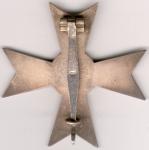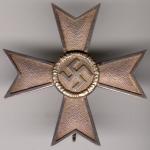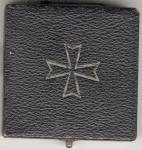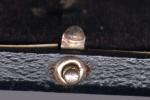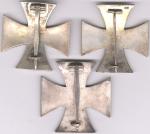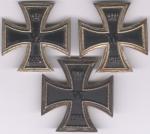
Mike K
For Deletion-
Posts
583 -
Joined
-
Last visited
Content Type
Profiles
Forums
Blogs
Gallery
Events
Store
Everything posted by Mike K
-
EK 1914 Rothe & Neffe EK1 ?
Mike K replied to Daniel Murphy's topic in Germany: All Eras: The Iron Cross
Hi Rick, I've been doing some more net research and I agree with the pre-22 (amd probably wartime) date. I have now read though that the A may not reference the Vienna assay office, but instead stand for "ausland" and mean an import item. Dan, withIN the Dianakopf there should be other markings (eg a number from 1 to 4 and a letter or letter number code) - what are they? Regards Mike -
EK 1914 Rothe & Neffe EK1 ?
Mike K replied to Daniel Murphy's topic in Germany: All Eras: The Iron Cross
Hi, Dan, interesting cross with very unusual markings! Joe, your comparison as requested. Two very different cores imo - frames also appear to be different, taking image distortions into account. The oval hinge-plate is common on WS examples, however the core on Dan's example does not match any of the 3 variants of WS cores I am aware of. WS were also into shaping/narrowing the top part of the pin, I assume for snug fitting into top uniform loops. I have to agree with Micha's statement - I have yet to see a KNOWN DEFINITE R&N produced/marked EK! Stogie Rick, do you have any images of all the other R&N EKs you're referring to?? I recall a Niemann cased set from years ago (very long case with EK2 OVER, not next to, the EK1) but alas there were no reverse images and the obverse image was pretty poor. Dan (and Rick L), regarding the markings and specifically the FR diamond marking (which I can't make out but I am not doubting you and understand the frustrations of imaging tiny markings in akward locations!), are any of the markings possibly IMPORT markings? For example, could the markings mean tax has been paid on a silver item imported by R&N into Austria?? I've never managed to pick up a copy of Tardy to try and figure these sorts of questions out. Regards Mike -
EK 1914 another 1914 EK 1
Mike K replied to joe campbell's topic in Germany: All Eras: The Iron Cross
No apologies necessary. I came over heavy because I didn't realise there was a "square" core the SAME as the CD800!! We both learnt something and contributed to the hobby at the same time - at that's the main thing Regards Mike -
Luftwaffe LUFT PO need some help here please
Mike K replied to notned's topic in Wehrmacht Medals, Decorations & Awards
Hi Paul, I'm thinking it's a cast repro. The markings are wrong as the PM font is way too large and the patina on the eagle certainly does not look like 900 silver. The obverse detail does not look great. One to avoid imo. Regards Mike PS: the eagle looks like a Juncker J3? -
Hi decker, The white stuff may possibly be residue from a chemical cleaner. Would really like to see some decent scans of this example. The obverse looks fine. The hinge and pin look OK (possibly some solder at the hinge though??). The catch is very unusual but imo no really obvious signs of repair from the images. I've seen a similar catch on a strangely marked EK1 before (a K in a circle from memory). I can't really make out the 800 well enough to comment either way. Interesting cross, but certainly not "textbook". Regards Mike
-
EK 1914 another 1914 EK 1
Mike K replied to joe campbell's topic in Germany: All Eras: The Iron Cross
Hi Micha, Yes, it looks like two dies (at least for the core) for the square/quadrant examples, but still a relationship between the square and CD 800 (and "Joe's") examples based on your pics. So it seems there are either two manufacturers involved and some die sharing or one manufacturer with at least two set of dies for cores and frames - as mentioned above. Both possibilities have precedents so I guess it's another confusing case of EK1 "inbreeding", at least until new information comes to light. Regards Mike -
EK 1914 another 1914 EK 1
Mike K replied to joe campbell's topic in Germany: All Eras: The Iron Cross
Same with the dates. My pin-back "square" marked example has a different core to the 800 (Joe's type) and CD 800 examples. Regards Mike -
EK 1914 another 1914 EK 1
Mike K replied to joe campbell's topic in Germany: All Eras: The Iron Cross
Close-up scans of the crowns of my 3 examples showing that the "square" marked example is different to the 800 and CD 800 examples (which are the same). -
Hi Steve, My little collection; The top two are imo wartime - one vaulted with strongly dished back, the other only vaulted - both are steel. Bottom left is a zinc screwback (same obverse design as the vaulted wartime example) and the bottom right example is tombak/bronze - probably 20s/30s with the classic folded over hinge. Pity about the replaced pin on the Prinzen!! Regards Mike
-
EK 1914 KMST Pinback at Ebay.de
Mike K replied to Motorhead's topic in Germany: All Eras: The Iron Cross
Rick, I see maybe two or three crosses of this type (ie with "normal" pinback and fold-up catch lock) a year for sale on eBay (I don't recall seeing any on most dealer sites recently) - maybe one of the complex "clip-backs" and even less of the diskback KMSTs. I don't think it's a "need it now" thing, I think it's a rarity thing for advanced EK collectors. As a reference, the last KMST I remember Niemann selling was 440 Euro, probably a couple of years ago now (not that I look in every week any more). I've seen the clip-backs sell for US$1000. There is one type of diskback which I simply have not seen for sale recently at all - if one comes up it will go for big dollars - unless you have one you want to part with for a few hundred US$??? Regards Mike -
EK 1914 KMST Pinback at Ebay.de
Mike K replied to Motorhead's topic in Germany: All Eras: The Iron Cross
Hi, I'd been watching the auction and actually thought it went for a fair price. If you want a cheap cross, buy a dirt-common KO. If you are into uncommon/rare variants, any KMST variant would be near the top of the desirability list. I picked up an unmarked KMST example myself not so long ago for a bit under 300 Euro, and I thought that was a pretty good price. Regards Mike -
Cased KvK without swords- marked "15"
Mike K replied to beertje's topic in State, Civil Awards & Decorations
Hi Marcus, Sorry for the late reply - was travelling to work. Yes, I still own this one - it's the only w/o swords I've kept. Don't have access to my records but it is not a recent purchase. Regards Mike -
Cased KvK without swords- marked "15"
Mike K replied to beertje's topic in State, Civil Awards & Decorations
-
Cased KvK without swords- marked "15"
Mike K replied to beertje's topic in State, Civil Awards & Decorations
-
Cased KvK without swords- marked "15"
Mike K replied to beertje's topic in State, Civil Awards & Decorations
Hi Martin, Some scans to follow as requested. Sorry, but I won't have time to take a pic of the inside of the case. Regards Mike Case top; -
Cased KvK without swords- marked "15"
Mike K replied to beertje's topic in State, Civil Awards & Decorations
Hi Marcus, My own cased 15 w/o swords came in exactly the same case as Martin's example - same catch and same stencilled design on the lid. The upper white silk insert has basically no soft padding - whatever is there is moderately thin and very firm. The lower black insert on my example is covered in Spruehfilz (a heavy covering though) so it may not be an early style case - ?mid-war? The insert is not loose so I don't know if it's marked underneath. Regards Mike PS: quick scan attached -
Hi Les, I agree with Darrell - absolutely, definitely not the same. For a start, the repros are one-piece examples from what I've read. Secondly, the core details are different. Look at the form of the 4, particularly note that vertical and diagonal strokes do not joint at the top of the repro, whereas they do on the ones discussed in this thread. Note also on the repro that the reverse of the repro main pin is "dished" whereas your type pin has bevelled edges. Initially when I was thinking your's may have had a replacement pin, I was thinking they may have used the repro type pin (these repros have been known for a while and have flooded the markte in the last few years). Now, although the pins appear similar from a distance (but aren't close up), it's more likely they've used your type of pin as the basis for their repro pin. Regards Mike
-
-
Hi Les, I tried again and this time it worked! Strange. OK, I'm going to revise what I wrote above. First up - the size of your cross; it's less than 44 mm isn't it? Closer to 43 mm? That's very important for determining period imo. Bill's example from the other thread - specifically the style and location of the 800 stamping - jogged my memory. Turns out I have not one but 3 examples with this core type (scans to follow). One of them I think is probably 30s (the needle-pin 800, possibly even 20s), another one I think is probably 30s/40s (the unmarked one with laid-down block hinge) and the 3rd one is definitely TR period (post-'41, LDO, L/54 marked). All 3 of my examples have (imo pressed) steel cores. The two upper ones are smaller - typical pre-TR - compared to the classic TR 44 mm L/54 marked example (they still share exactly the same core though). I have a couple of 1914 57ers and although they have SIMILAR crowns the dates are definitely different, therefore imo they came from different dies. As such, I don't think your example is a 57er (different core and different size). It's probably 30s produced like my two top ones and as Bill's example shares the same pin the pin must simply be a variation with this maker, rather than a replacement. Regards Mike
-
Hi Les, Sorry, can't comment on that badge as I can't see it. I do not subscribe to that forum. Regards Mike
-
Hi Les, Thanks for the additional pictures. The only thing I can add - probably towards a replaced pin conclusion - is that the central segment is not a good fit (still looks like a different OD as well). Sounds like you've gone as far as you can go with it though. Regards Mike
-
Hi Matt, I can only agree with the others - it looks like a very nice example with an uncommon hinge/pin construction. Regards Mike
-
Hi Don, Not a bad example of a not so common maker! Looks like no core cracks either!! Both examples I've owned of this type have had cracked cores, to me indicating very thin cast/struck iron (as opposed to sheet metal cores). Both of my examples have also had dangerously sharp/pointy main pin ends. I've seen some of these with 800 markings on the pin as well. Regards Mike
-
Hi Les, The obverse looks fine and would be correct for 40s onwards (ie TR LDO or earlier 57er re-issue). The reverse appears to be well aged, except the pin. Also, hard to tell from the image, but the central segment of the hinge (attached to the pin) appears to be a different OD to the two outer segments. Imo the pin is unusual for any period and I think there is a possibility that it is a total replacement. Any chance of a "square-on" reverse image? A shot of the hinge with the main pin up, focusing on where the pin rests on the back of the cross (at the base of the hinge), may also reveal the impression of a previously replaced main pin. Regards Mike






